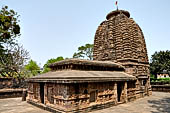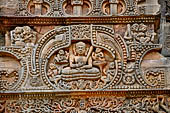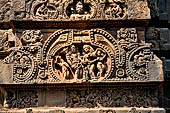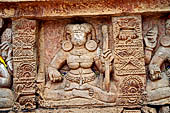| enter keyword to search: |
|
Images db
|
|
|
Articles db
|
|
|
|
|
|
|
|
|
Substantially intact in its original form, Parsurameswara (c. 650 AD) is the earliest best-preserved of Bhubaneshwar temples. Its name derives from the deity Parasesvara or Parasaresvara, which means the Lord 'Parasara' (a form of Shiva), a teacher of the Pasupata sect.
Located in a pit surrounded by compound walls rising just above the street level, Parsurameswara has a rectangular jagamohana and a deul in a fully developed rekha order. The jagamohana, with its two-stage only roof, has not yet developed into a mature pidha order.
Dedicated to Lord Shiva, although there is not a Nandi, in a corner of the courtyard there is an intriguing lingam, the Sahasralingam, decorated with thousand miniature self-replica.
Parsurameswar Mandir |

|
The tower has three aedicule niches on each face. Shaped almost like a monumental door, the central niche is flanked by two subsidiary ones. The main projection (rahapaga) on each face of the deul, is a clear continuation of the central niche of the base. This projection is decorated with impressive vajra-mastaka: a vertical composition of superimposed horseshoe chaitya medallions of diminishing sizes, with inside images like dancing Shiva.
In the central niche of the Southern Face the image of Ganesa and, in the medallion above, Shiva begs food from Parvati a motif taken from the Puranas.

|
Parsurameswar Mandir
|
In the central niche of the Eastern Face the image of Kattrikeya, the other son of Shiva, sitting on a throne and holding a spear and a citron. Below him the peacock, his mount, killing a snake. The lintel of the niche is carved with an assembly of gods. In the medallion above the central niche an image of Lakulisha the mythical founder of the Pasupata sect, represented seated cross-legged on a lotus, urdhvalinga (with erected penis), a posture reminiscent of the Buddha when delivered the first sermon of the sacred Wheel of Law. He holds a club and a rosary (his identifying features) and is surrounded by his four disciples with manuscripts.
In the Northern face, a multi-armed Durga, killing the buffalo demon.
In the central projection of the Western Face of the tower we can notice inside the-horse shoe arches, from the top in descending order, the images of: Lakulisa, Shiva Nataraja and the beautiful chaitya medallion with the relief of Ravana shaking mount Kailash with, on top, the couple Shiva and Parvati (she is holding his erect phallus).
Parsurameswar Mandir |

|
The western doorway of the jagamohan is the main entrance of the temple. In addition in the south side there is also a secondary entrance. Light enters the interior through latticed windows on north and south walls.
On the North Wall of the jagamohana there one of the earliest representation of the saptamatrikas set represented along with Ganesha and Virabhadra: Ganesha is with no mount, next is Chamunda mounted on an owl (later representations show her on a corpse eaten by jackals), Varahi with the axe and mounted on the elephant, Indrani with the vajra and mounted on the elephant, Vaishnavi with the Vishnu's conch her vahana is Garuda, Kumari with her spear her vahana is the peacock, Brahmani seated on a lotus and a swan as vahana, Maheshvari with the trident and the rosary, sweet expression, distinctive headdress and large ear spools the vahana is Nandi (the bull).

|
Parsurameswar Mandir
|
South Wall of the jagamohana. In row from the left: two Dikpalas, a latticed window, three images of dikpalas (Varuna, Yama and Indra) the south entrance.
West Wall on both sides of the entrance: two panels with dancing figures in elaborate postures.
Parsurameswar Mandir |

|
| |
|
|
 |
|
|



